An Energy Centric Cluster-Based Routing Protocol for Wireless Sensor Networks
Abstract
:1. Introduction
2. Literature Review
3. Preliminaries
3.1. Network Model and Assumptions
3.2. Energy Consumption Model
3.3. Data Aggregation Model
4. The Protocol Details
4.1. Cluster Setup Phase
| Algorithm 1. Cluster Setup |
| 1: start (information collection) |
| 2: while (T1 has not expired) do |
| 3: BS broadcasts Hello_Msg1 |
| 4: Nodes receive the message |
| 5: Measure distance from BS |
| 6: si.state ← Normal |
| 7: Broadcast Hello_Msg |
| 8: Receive and update CMT |
| 9: end |
| 10: end |
4.2. Cluster-Head Election Phase
| Algorithm 2. Cluster Head Election |
| 1: start (cluster head election among nodes) |
| 2: while (T2 has not expired) do |
| 3: state ← Candidate |
| 4: if (round, r == 1) then |
| 5: Broadcast Node_Msg |
| 6: Receive and update CMT[si] |
| 7: Find a higher rank node |
| 8: state ← Normal |
| 9: CMT[si].state ← Head |
| 10: Broadcast Schedule_Msg |
| 11: else if (round, r > 1 && si is a former cluster head of r − 1) then |
| 12: Find a member node with a higher rank |
| 13: Find missing node id |
| 14: Send Handover_Msg |
| 15: Find cluster head id |
| 16: state ← Normal |
| 17: CMT[sj].state ← Head |
| 18: Broadcast Schedule_Msg |
| 19: if (no Schedule_Msg has received) then |
| 20: Repeat the cluster head election process as r ==1 |
| 21: end |
| 22: end |
| 23: end |
| 24: end |
4.3. Data Transmission Phase
| Algorithm 3. Data transmission. |
| 1: start (cluster-based hierarchical routing) |
| /* intra-cluster communication |
| 2: while (T3 has not expired) do |
| 3: Piggyback rank values along with local data to cluster heads |
| 4: Cluster heads receive and aggregate the data |
| 5: end |
| /* inter-cluster communication |
| 6: while (T4 has not expired) do |
| 7: if (si.state == ‘Head’) then |
| 8: Compute the value of rank |
| 9: Broadcast Route_Msg |
| 10: Receive and update RT |
| 11: if (d(si,BS) ≤ Rmax) then |
| 12: nexthop ← BS |
| 13: else |
| 14: Find a CH with a higher rank among less distant CHs from BS |
| 15: nexthop ← CH |
| 16: Send aggregated data |
| 17: end |
| 18: end |
| 19: end |
| 20: end |
4.3.1. Intra-Cluster Communication
4.3.2. Inter-Cluster Communication
5. Performance Evaluation
5.1. Simulation Setup
5.2. Network Lifetime
5.3. Discussion
- Periodic clustering approach of the existing protocols requires an additional energy consumption of the nodes for broadcasting and receiving a number of control messages in every round. Unlike re-clustering of the protocols, the static clusters of ECCR do not require any control message after the initial clusters formation. Hence, this saves the energy consumption of the nodes in this regard for rest of network operation.
- The cluster head elections of EADUC, HUCL and IEADUC are based on the residual energy of nodes where the average distance among the neighbor nodes has not taken into consideration. Only the residual energy of a node might not be an effective factor to select a cluster head, even though a node with a higher residual energy can sustain as a cluster head for a longer period of time. In these protocols, a node with a higher residual energy as a cluster head does not guarantee the minimum amount of energy consumption during the intra-cluster communication. It may happen due to the higher communication distance between the cluster head and member nodes. Meanwhile, the common cluster head election process of the protocols does not guarantee that only the higher residual-energy-obtained nodes are elected as the cluster heads across the network. Some of the cluster heads might have less residual energy compared to their member nodes due to the biased time T and cluster formation policies. Thus, the energy consumption among the nodes is not properly balanced, and some nodes may die quickly as a result. In contrast, our proposed cluster-head election technique is based on the ranks of the nodes and considers the residual energy and average distance among member nodes as well. Along with the balancing energy consumption of the nodes, the proposed method saves the energy of the nodes during intra-cluster communication over the network. Moreover, the piggyback and caretaker techniques in cluster-head election reduce a significant number of control messages throughout the network lifetime as in HUCL and IEADUC.
- A shortest route considering only the distance from a cluster head to the BS for data forwarding might cause the packets dropped of aggregated data packets at a certain relay node due to the lack of residual energy of the node to process the data and transmits to the next hop towards the BS, such as in EADUC. Distributing a load of aggregated packets across the network might not only increase the number of hops but also might consume an additional amount of energy of the associated cluster heads in the routes. It impacts on the overall network lifetime, such as in EADC. Instead, our adopted route selection towards the BS constructs a preferable energy-efficient route. It associates the cluster heads with higher ranks. The selection process considers the residual energy, number of member nodes, and distance from the BS. The method balances the energy consumption of the cluster heads as well as minimizes the number of average hops, which is more energy efficient in this regard.
6. Conclusions
Author Contributions
Funding
Acknowledgments
Conflicts of Interest
References
- Al-Fuqaha, A.; Guizani, M.; Mohammadi, M.; Aledhari, M.; Ayyash, M. Internet of Things: A survey on enabling technologies, protocols, and applications. IEEE Commun. Surv. Tutor. 2015, 17, 2347–2376. [Google Scholar] [CrossRef]
- Qin, Y.; Sheng, Q.Z.; Falkner, N.J.G.; Dustdar, S.; Wang, H.; Vasilakos, A.V. When things matter: A survey on data-centric internet of things. J. Netw. Comput. Appl. 2016, 64, 137–153. [Google Scholar] [CrossRef]
- Sarkar, A.; Murugan, T.S. Routing protocols for wireless sensor networks: What the literature says? Alex. Eng. J. 2016, 55, 3173–3183. [Google Scholar] [CrossRef]
- Pantazis, N.A.; Nikolidakis, S.A.; Vergados, D.D. Energy-efficient routing protocols in wireless sensor networks: A survey. IEEE Commun. Surv. Tutor. 2013, 15, 551–591. [Google Scholar] [CrossRef]
- Heinzelman, W.R.; Chandrakasan, A.; Balakrishnan, H. Energy-efficient communication protocol for wireless microsensor networks. In Proceedings of the 33rd Annual Hawaii International Conference on System Sciences, Maui, HI, USA, 7 January 2000; pp. 1–10. [Google Scholar]
- Smaragdakis, G.; Matta, I.; Bestavros, A. SEP: A stable election protocol for clustered heterogeneous wireless sensor networks. In Proceedings of the 2nd International Workshop on Sensor and Actor Network Protocols and Applications, Boston, MA, USA, 22 August 2004; pp. 1–11. [Google Scholar]
- Attea, B.A.; Khalil, E.A. A new evolutionary based routing protocol for clustered heterogeneous wireless sensor networks. Appl. Soft Comput. 2012, 12, 1950–1957. [Google Scholar] [CrossRef]
- Kumar, S.; Verma, S.K.; Kumar, A. Enhanced threshold sensitive stable election protocol for heterogeneous wireless sensor network. Wirel. Pers. Commun. 2015, 85, 2643–2656. [Google Scholar] [CrossRef]
- Mhatre, V.; Rosenberg, C. Homogeneous vs heterogeneous clustered sensor networks: A comparative study. In Proceedings of the IEEE International Conference on Communications, Paris, France, 20–24 June 2004; pp. 3646–3651. [Google Scholar]
- Kang, S.H.; Nguyen, T. Distance based thresholds for cluster head selection in wireless sensor networks. IEEE Commun. Lett. 2012, 16, 1396–1399. [Google Scholar] [CrossRef]
- Younis, O.; Fahmy, S. HEED: A hybrid, energy-efficient, distributed clustering approach for ad hoc sensor networks. IEEE Trans. Mob. Comput. 2004, 3, 366–379. [Google Scholar] [CrossRef]
- Yongtao, C.A.O.; Chen, H.E. A distributed clustering algorithm with an adaptive backoff strategy for wireless sensor networks. IEICE Trans. Commun. 2006, 89, 609–613. [Google Scholar]
- Dimokas, N.; Katsaros, D.; Manolopoulos, Y. Energy-efficient distributed clustering in wireless sensor networks. J. Parallel Distrib. Comput. 2010, 70, 371–383. [Google Scholar] [CrossRef]
- Kuila, P.; Gupta, S.K.; Jana, P.K. A novel evolutionary approach for load balanced clustering problem for wireless sensor networks. Swarm Evolut. Comput. 2013, 12, 48–56. [Google Scholar] [CrossRef]
- Kuila, P.; Jana, P.K. Approximation schemes for load balanced clustering in wireless sensor networks. J. Supercomput. 2014, 68, 87–105. [Google Scholar] [CrossRef]
- Qing, L.; Zhu, Q.; Wang, M. Design of a distributed energy-efficient clustering algorithm for heterogeneous wireless sensor networks. Comput. Commun. 2006, 29, 2230–2237. [Google Scholar] [CrossRef]
- Soro, S.; Heinzelman, W.B. Prolonging the lifetime of wireless sensor networks via unequal clustering. In Proceedings of the 19th IEEE International Parallel and Distributed Symposium, Denver, CO, USA, 4–8 April 2005; pp. 1–8. [Google Scholar]
- Li, C.; Ye, M.; Chen, G.; Wu, J. An energy-efficient unequal clustering mechanism for wireless sensor networks. In Proceedings of the IEEE International Conference on Mobile Adhoc and Sensor Systems, Washington, DC, USA, 7 November 2005; pp. 1–8. [Google Scholar]
- Yu, J.; Qi, Y.; Wang, G.; Guo, Q.; Gu, X. An energy-aware distributed unequal clustering protocol for wireless sensor networks. Int. J. Distrib. Sens. Netw. 2011, 2011, 1–8. [Google Scholar] [CrossRef]
- Yu, J.; Qi, Y.; Wang, G.; Gu, X. A cluster-based routing protocol for wireless sensor networks with nonuniform node distribution. Int. J. Electron. Commun. 2012, 66, 54–61. [Google Scholar] [CrossRef]
- Mehmood, A.; Khan, S.; Shams, B.; Lloret, J. Energy-efficient multi-level and distance aware clustering mechanism for WSNs. Int. J. Commun. Syst. 2015, 28, 972–989. [Google Scholar]
- Gu, X.; Yu, J.; Yu, D.; Wang, G.; Lv, Y. ECDC: An energy and coverage-aware distributed clustering protocol for wireless sensor networks. Comput. Electr. Eng. 2014, 40, 384–398. [Google Scholar] [CrossRef]
- Amgoth, T.; Jana, P.K. Energy-aware routing algorithm for wireless sensor networks. Comput. Electr. Eng. 2015, 41, 357–367. [Google Scholar] [CrossRef]
- Sabet, M.; Naji, H.R. A decentralized energy efficient hierarchical cluster-based routing algorithm for wireless sensor networks. Int. J. Electron. Commun. 2015, 69, 790–799. [Google Scholar] [CrossRef]
- Xu, Z.; Chen, L.; Cao, L.; Liu, T.; Yang, D.; Chen, C. DARC: A distributed and adaptive routing protocol in cluster-based wireless sensor networks. Int. J. Distrib. Sens. Netw. 2015, 2015, 1–14. [Google Scholar] [CrossRef]
- Malathi, L.; Gnanamurthy, R.K.; Chandrasekaran, K. Energy efficient data collection through hybrid unequal clustering for wireless sensor networks. Comput. Electr. Eng. 2015, 48, 358–370. [Google Scholar] [CrossRef]
- Gupta, V.; Pandey, R. An improved energy aware distributed unequal clustering protocol for heterogeneous wireless sensor networks. Int. J. Eng. Sci. Technol. 2016, 19, 1050–1058. [Google Scholar] [CrossRef]
- Lloret, J.; Garcia, M.; Bri, D.; Diaz, J.R. A cluster-based architecture to structure the topology of parallel wireless sensor networks. Sensors 2009, 9, 10513–10544. [Google Scholar] [CrossRef] [PubMed]
- Qin, Y.; Wang, H.; Sun, L. Cluster-based scheduling algorithm for periodic XML data broadcast in wireless environments. In Proceedings of the IEEE Workshops of International Conference on Advanced Information Networking and Applications, Singapore, 22–25 March 2011; pp. 1–6. [Google Scholar]
- Zhang, Y.; Wang, J.; Han, D.; Wu, H.; Zhou, R. Fuzzy-logic based distributed energy-efficient clustering algorithm for wireless sensor networks. Sensors 2017, 17, 1–21. [Google Scholar] [CrossRef] [PubMed]
- Li, B.; Cui, W.; Wang, B. A robust wireless sensor network localization algorithm in mixed LOS/NLOS scenario. Sensors 2015, 15, 23536–23553. [Google Scholar] [CrossRef] [PubMed]

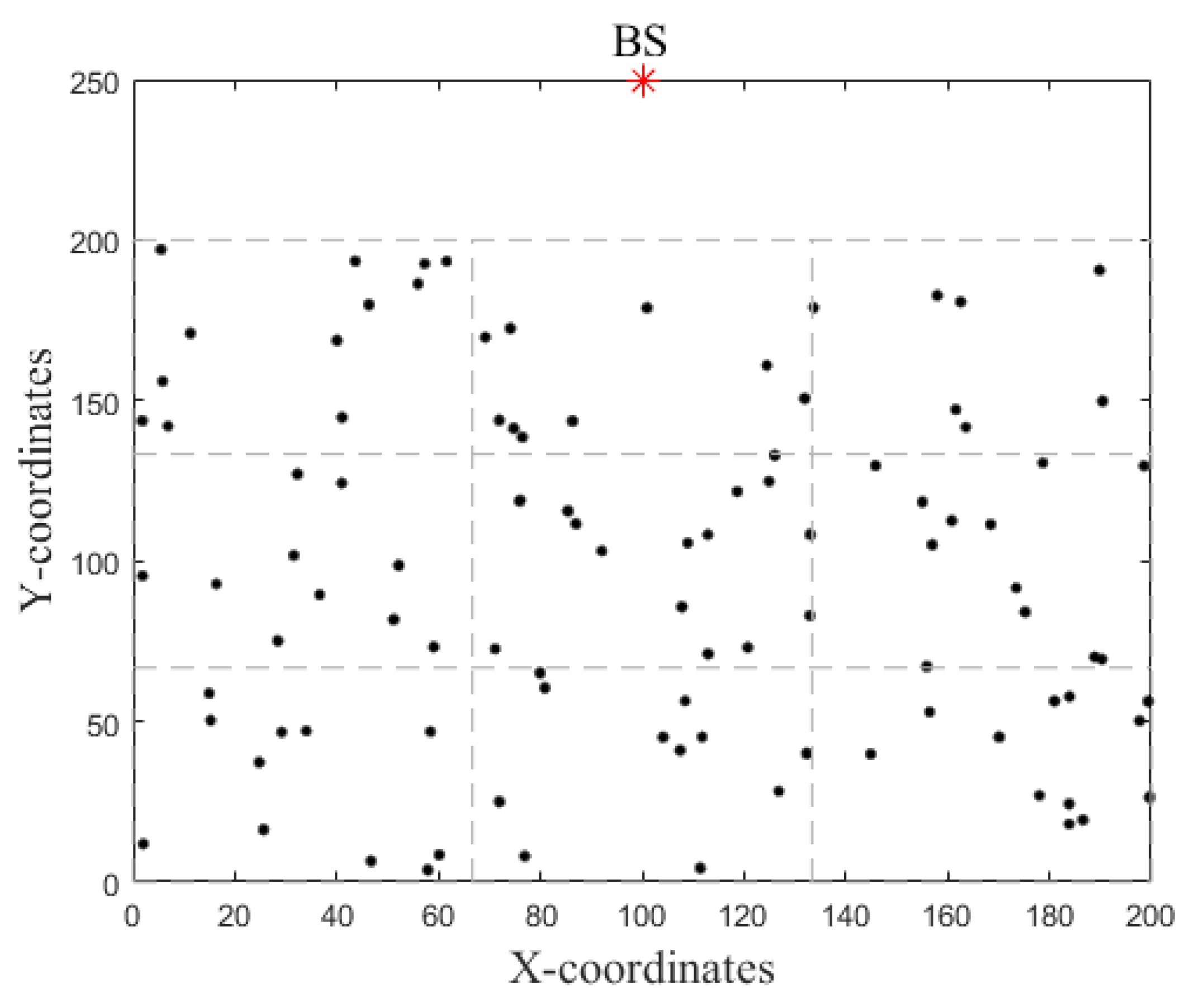
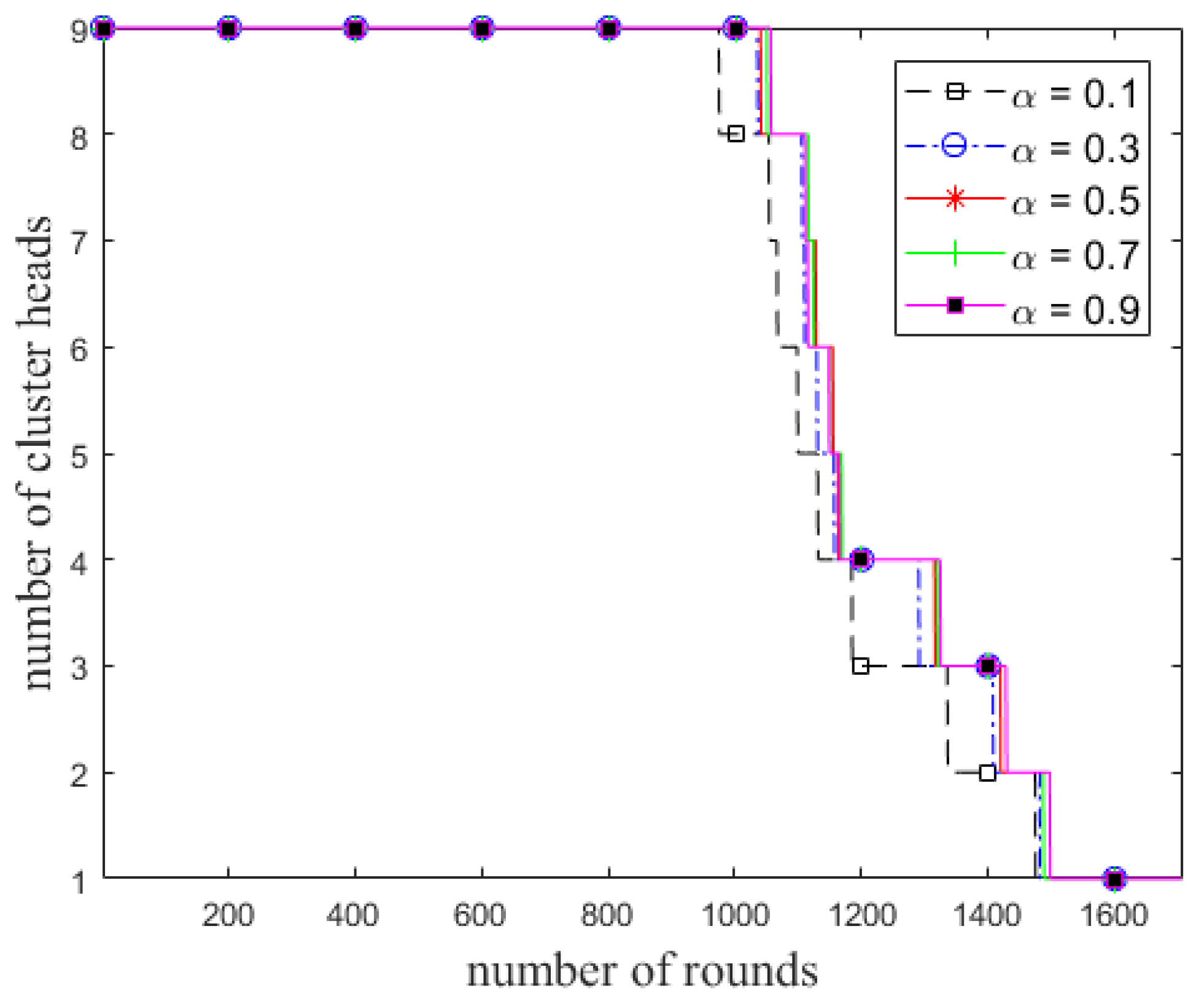
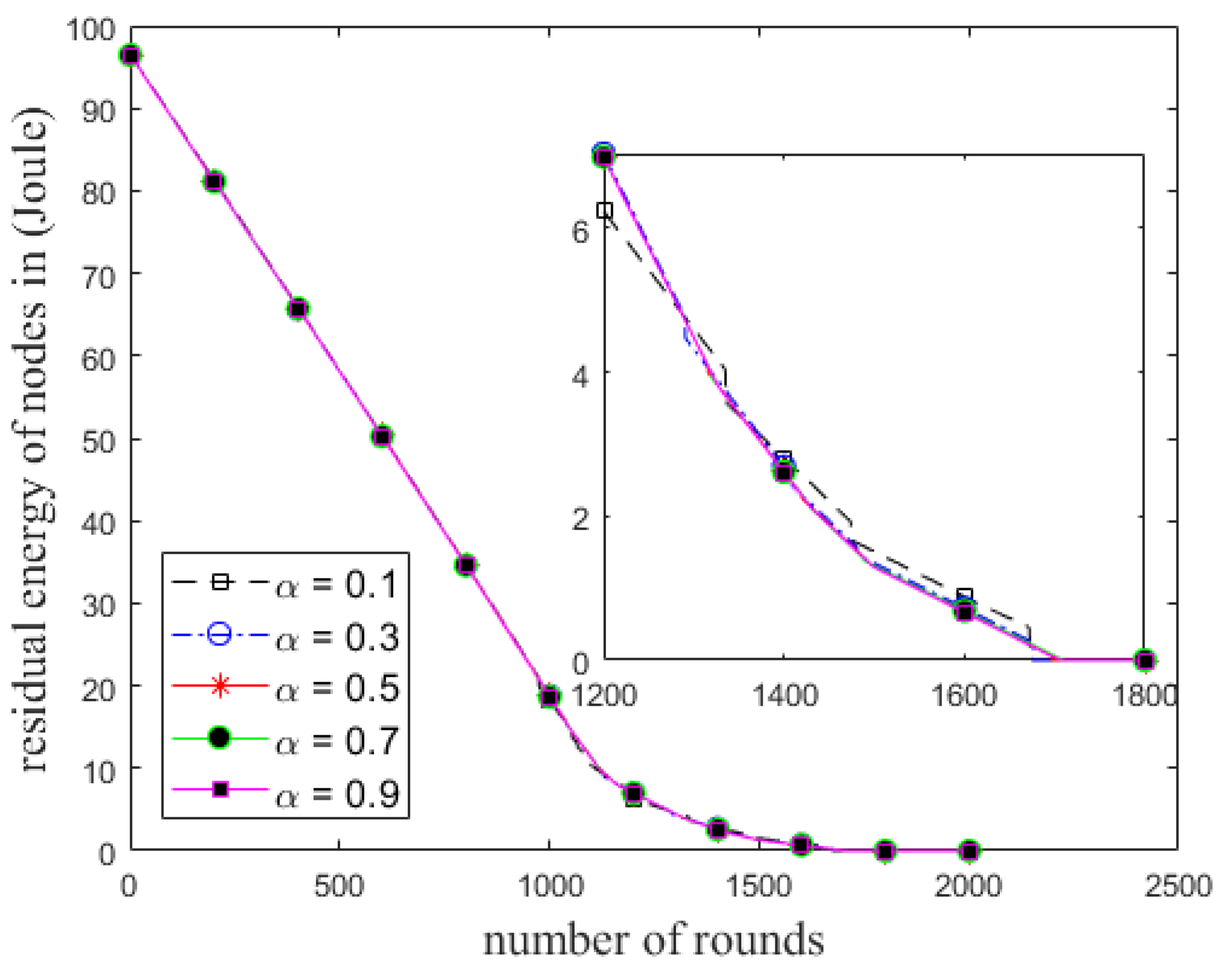
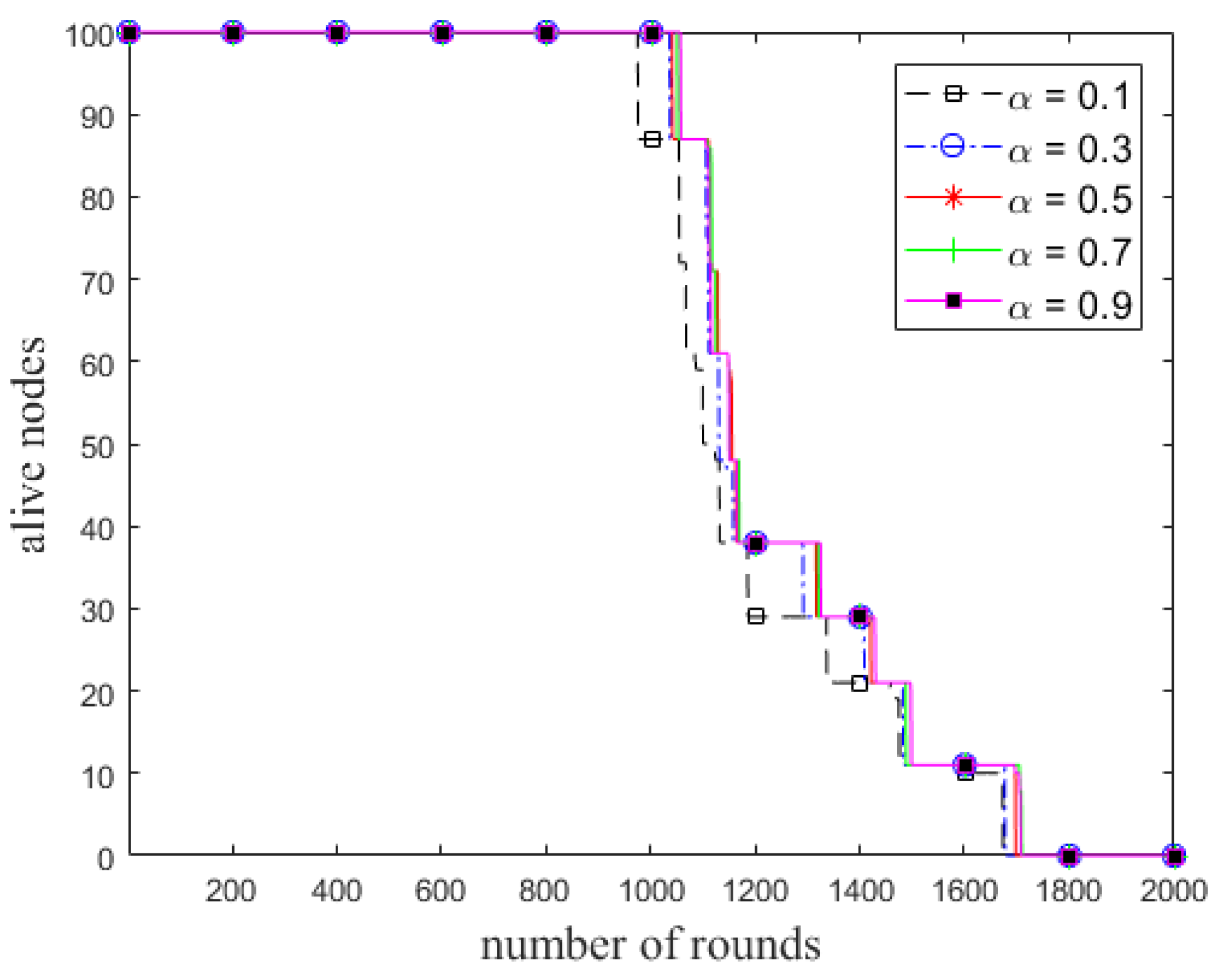


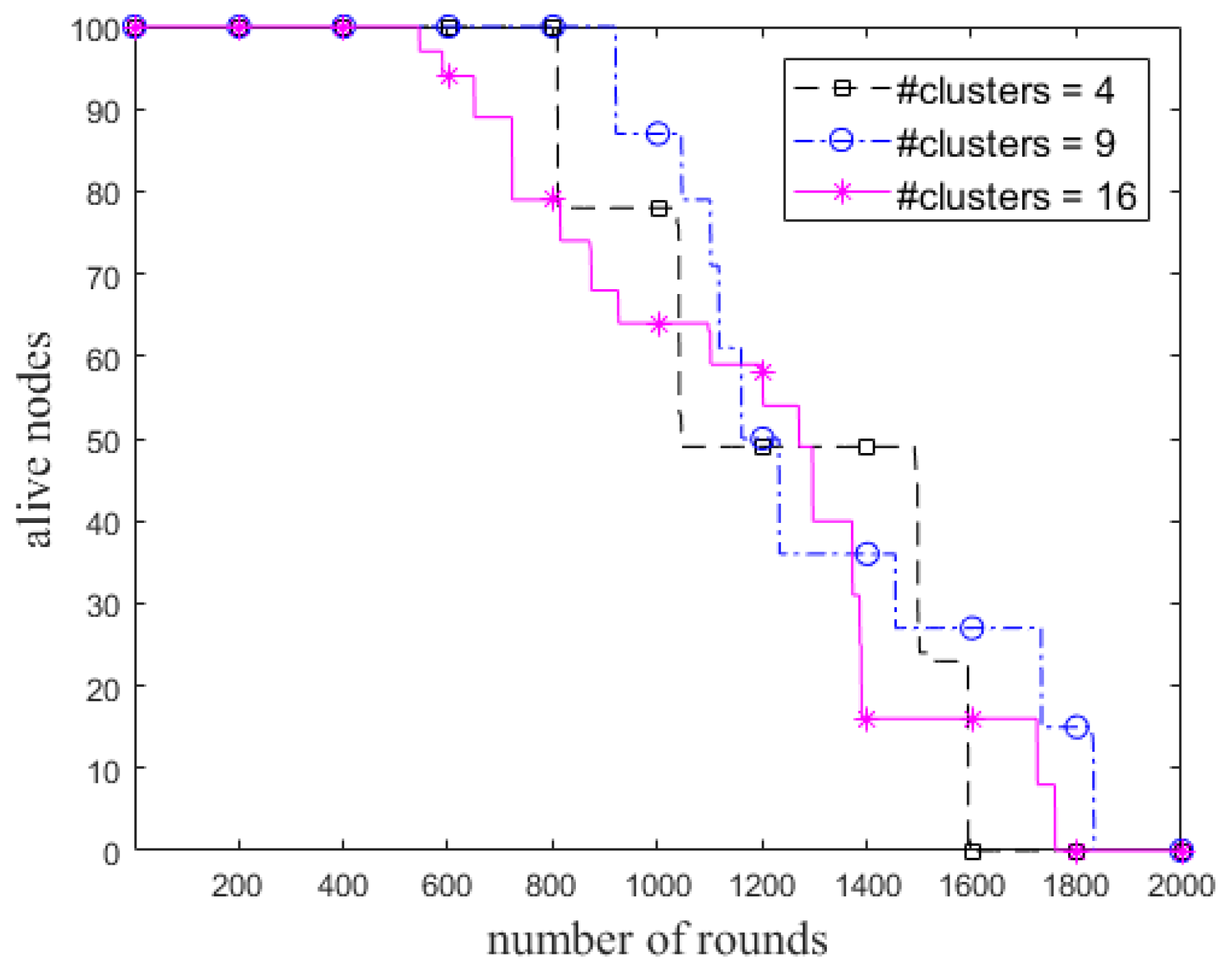

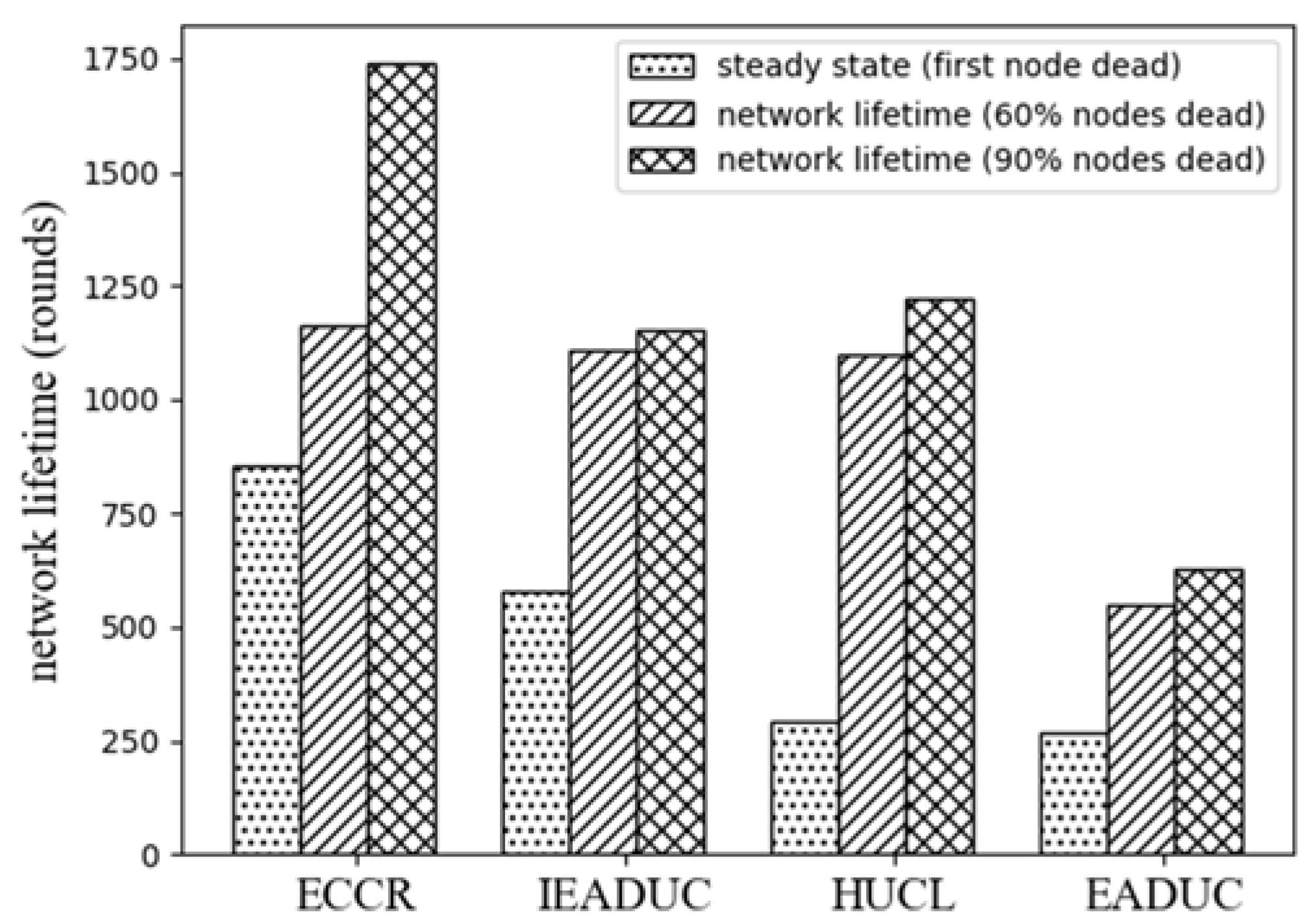
| Protocol | Clustering | Scalability (Single-Hop or Multi-Hop) | Control Message Overhead | Steady State of the Network | Network Lifetime |
|---|---|---|---|---|---|
| LEACH | dynamic | single-hop | medium | very low | very low |
| SEP | √ | √ | √ | low | medium |
| ERP | √ | √ | √ | √ | √ |
| ETSSEP | √ | √ | √ | medium | √ |
| M-LEACH | √ | multi-hop | √ | low | low |
| LEACH-DT | √ | √ | √ | √ | medium |
| HEED | √ | √ | high | √ | low |
| DCAAB [12] | √ | single-hop | √ | √ | √ |
| GESC [13] | √ | multi-hop | √ | √ | medium |
| ELBC [14] | static | single-hop | √ | medium | high |
| ALBC [15] | √ | √ | √ | √ | √ |
| DEEC | dynamic | √ | medium | low | low |
| PLUC [17] | √ | multi-hop | √ | √ | √ |
| EEUC | √ | √ | √ | medium | √ |
| EADUC | √ | √ | high | √ | medium |
| EADC | √ | √ | √ | √ | √ |
| EEMDC | hybrid | √ | √ | √ | √ |
| ECDC | dynamic | √ | √ | √ | √ |
| ERA | √ | √ | medium | √ | high |
| DHCRA | √ | √ | √ | √ | √ |
| DARC | √ | √ | √ | √ | medium |
| HUCL | hybrid | √ | low | high | high |
| IEADUC | √ | √ | √ | √ | √ |
| Message | Description |
|---|---|
| Hello_Msg | Tuple (selfid, clusterid), a control message of nodes’ initial information. |
| Node_Msg | Tuple (selfid, selfrank, selfenergy), a control message of members’ information. |
| Handover_Msg | Tuple (selfid, clusterid, headid), a control message of hand over the role of cluster head to a prospective cluster head in a cluster. |
| Schedule_Msg | Tuple (schedule, order), a control message for assign the time slot for a member node to send local data to an associate cluster head. |
| Route_Msg | Tuple (selfid, selfrank, selfenergy, disttoBS), a control message to collect neighbor cluster heads’ information. |
| D_Msg | Tuple (selfid, clusterid, selfrank, selfenergy, ‘local data’), a local data message from a member node to associate cluster head. |
| AD_Msg | Tuple (selfid, clusterid, nexthopid, ‘fused data’), an aggregated data message from a cluster head to a next hop or BS. |
| Parameter | Value |
|---|---|
| Location of the BS | (100,250) m |
| Number of nodes, N | 100 |
| Initial energy, Eini | 0.5–1.5 J |
| Control packet size, l | 25 bytes |
| Data packet size, l | 500 bytes |
| Transmitter or receiver circuitry, Eelec | 50 nJ/bit |
| Data aggregation cost, Eda | 5 nJ/bit/signal |
| Computation cost of rank and energy, Ecom | 5 nJ/bit/signal |
| Transmit amplifier cost, εmp, if (d > d0) | 0.0013 pJ/bit/m4 |
| Transmit amplifier cost, εfs, if (d ≤ d0) | 10 pJ/bit/m2 |
| Diagonal length of a grid, Rd | √2 × (M/3) = 94.28 m |
| Maximum transmission range, Rmax | 2 × Rd = 188.56 m |
| Weight factor, α | 0.8 |
© 2018 by the authors. Licensee MDPI, Basel, Switzerland. This article is an open access article distributed under the terms and conditions of the Creative Commons Attribution (CC BY) license (http://creativecommons.org/licenses/by/4.0/).
Share and Cite
Hosen, A.S.M.S.; Cho, G.H. An Energy Centric Cluster-Based Routing Protocol for Wireless Sensor Networks. Sensors 2018, 18, 1520. https://doi.org/10.3390/s18051520
Hosen ASMS, Cho GH. An Energy Centric Cluster-Based Routing Protocol for Wireless Sensor Networks. Sensors. 2018; 18(5):1520. https://doi.org/10.3390/s18051520
Chicago/Turabian StyleHosen, A. S. M. Sanwar, and Gi Hwan Cho. 2018. "An Energy Centric Cluster-Based Routing Protocol for Wireless Sensor Networks" Sensors 18, no. 5: 1520. https://doi.org/10.3390/s18051520
APA StyleHosen, A. S. M. S., & Cho, G. H. (2018). An Energy Centric Cluster-Based Routing Protocol for Wireless Sensor Networks. Sensors, 18(5), 1520. https://doi.org/10.3390/s18051520





